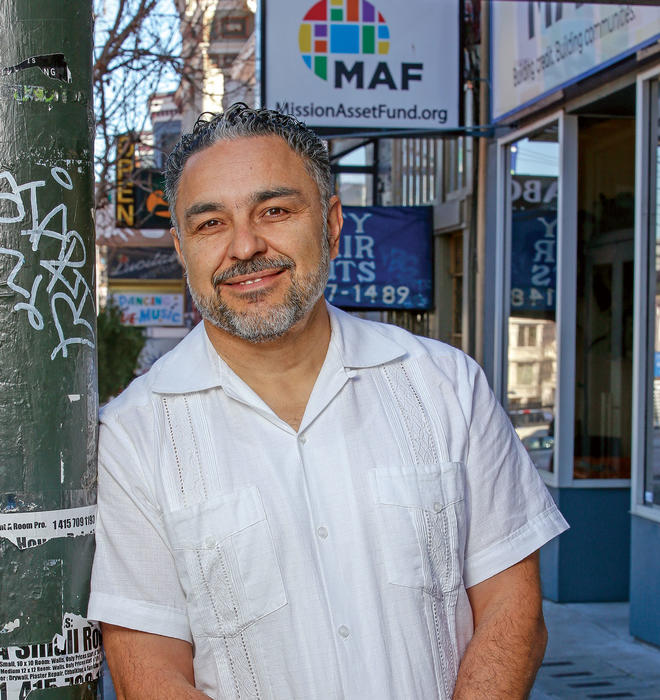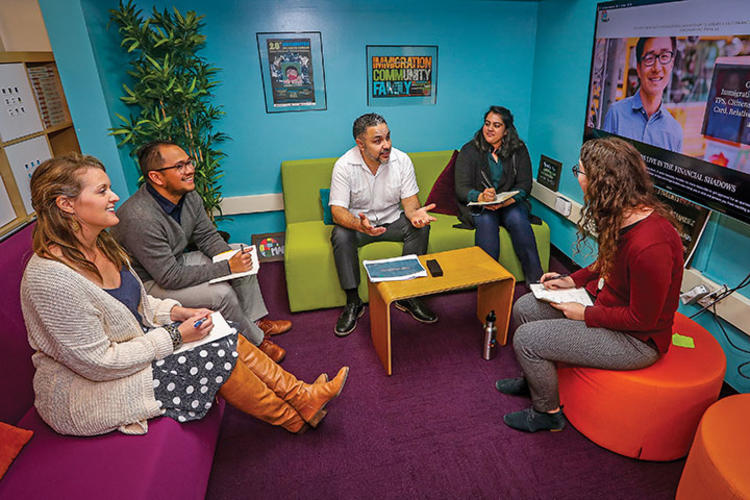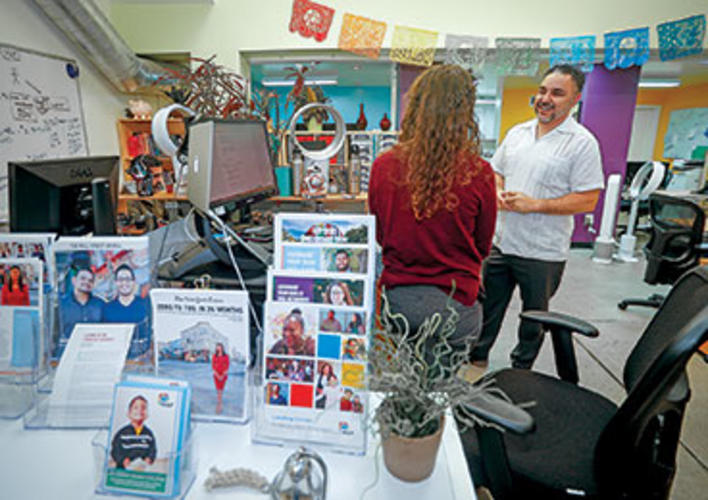
Credit Builder
José Quiñonez *98 helps people pool their money to open financial doors — and change lives
Even at mid-afternoon, before the dinner rush, Isabel Caudillo is too busy behind the counter to chat with a visitor to her restaurant. Such is the life of a small-business owner. El Buen Comer (“Good Eating”), on Mission Street in San Francisco’s Bernal Heights neighborhood, serves authentic Mexican dishes made from scratch, and Caudillo makes all the sauces herself.
Caudillo’s is a true American immigrant tale. She came to the United States in 2001 from Mexico City with nothing except a love of cooking. At home she would prepare traditional foods such as stews, beans and rice, and her mother’s mole verde that reminded her of home. A San Francisco community group helped her open a small stand in the Noe Valley Farmers Market, but the low profit margins made it impossible for her to grow.
An industrial steamer, which she needed to make her tamales, cost $1,400, far more than Caudillo had saved. Through a friend, she heard about the Mission Asset Fund (MAF), a community nonprofit organization headed by José Quiñonez *98 that administers “lending circles,” small person-to-person savings groups, to help low-income people put aside money and build credit.
Not only was Caudillo able to save enough to buy a steamer, but by reporting her lending-circle payments to credit agencies, the MAF made it possible for her to build a high credit score, which in turn enabled her to obtain a bank loan she used to open her second location.
“Lending circles were our first financial door,” Caudillo says in a testimonial on the organization’s website. “They gave me access to loans to open my own restaurant, which is something I never could have imagined. But more important than that, they helped me learn to manage the financial system to open even more opportunities in the future.”
Quiñonez, a soft-spoken man with a trim salt-and-pepper beard, was brought to the United States illegally when he was a child and grew up poor. Today he has a community organizer’s gift for phrasemaking. He often reasons by antitheses, one of which is this: Being poor is expensive. Lacking access to mainstream banking services, the poor must rely on high-fee check-cashing stores and usurious payday loans. And those who repay these loans receive no recognition in the form of an improved credit score. The Consumer Financial Protection Bureau estimates that 27 percent of Latinos in this country are “credit invisible,” meaning that credit-reporting agencies have no record of them. And without a good score, it is difficult or even impossible to get a credit card, rent an apartment in a good building, or make purchases except with cash.
“Credit reports are like passports,” Quiñonez explains in an essay for the book What It’s Worth: Strengthening the Financial Future of Families, Communities, and the Nation, published in part by the Federal Reserve Bank of San Francisco: “They are documents required to enter the financial mainstream.”
In 2016, Quiñonez was recognized with a MacArthur Foundation “genius” grant lauding him as a “financial services innovator.” He summarizes those innovations with two more antitheses. By “formalizing informality,” he tells PAW, the Mission Asset Fund hopes “to make the invisible visible.” And visible not only to banks: Quiñonez suggests that many well-meaning progressives need to see the poor differently, as well.
Lending circles exist all around the world. In Mexico, they are known as tandas. In Brazil, as pandieros. In Asia, as huis. In Africa and the Caribbean, as susus. They are a simple but effective way to save money.
Six people, for example, might agree to form a circle, each putting $100 a month into a common pot. Every month, one of them receives the entire $600 while all continue to pay monthly until everyone has received a payout. As a disciplined form of savings, lending circles have advantages over squirreling cash away in a coffee jar; like Weight Watchers, it has been suggested, they are a way for people to work toward a goal within a group rather than alone.
This is where the Mission Asset Fund steps in. It organizes the lending circles, processes the payments without charging interest or a service fee, and — most important — reports them to the major national credit bureaus such as Equifax, TransUnion, and Experian. By the time a lending circle is complete, each participant will have received a few hundred dollars, but everyone will also have built a credit history that can someday enable them to walk into a bank and get a loan.
A 2013 audit by the César E. Chávez Institute at San Francisco State University found that participants in MAF lending circles saw their credit scores rise by an average of 168 points. Still, with the goal of getting people quickly into the financial mainstream, its lending circles are intentionally kept small. The maximum payout is $2,400 and the maximum term is 12 to 18 months. The MAF has made some small-business loans but prefers to remain focused on lending circles.
“We didn’t want to present ourselves as the lender of choice for our clients,” Quiñonez explains. “Our strategy is to prepare them so that they can walk into the Chases and Citibanks of the world and get their capital, because that’s what they’re there for. We just want to be the first rung on that ladder.”
Nevertheless, the payoff of an improved credit score can be substantial. “Instead of getting a 12 or 13 percent APR auto loan, maybe they can get one for 10 percent or 8 percent,” Quiñonez reasons, “so instead of paying $500 a month, maybe they’re paying $400. That’s money they can keep in their pockets and pay for everything else in their lives.”
Shweta Kohli is one who has done just that. The Kuwaiti-born manager at Oracle has participated in nine lending circles over the last six years. Her credit score was lower than 100 when she joined her first circle soon after graduating from San Francisco State. It is now higher than 820, and she has to shoo away lenders plying her with pre-approved credit cards.
“Once I hit [a credit score of] 800, I can’t even tell you how much junk I got in the mail,” she says, laughing, and she and her husband are now applying for a mortgage to buy their own home. She still participates in lending circles, mostly for fun.
“The best feeling from doing a lending circle is not just to see your credit score go up, but when you get that payout and you didn’t have to pay any interest on it, it’s like giving yourself a loan.”
One risk is that those in the circle who receive their payout early will disappear, leaving the others holding the bag. The MAF protects against this by carefully screening its applicants — all must have identification, a bank account, and a source of income — and insisting that everyone take an online financial-education class and sign a promissory note pledging to make their payments on time. It seems to work; Quiñonez says that the default rate for MAF lending circles is just 0.7 percent. If someone does fall behind on a payment, the MAF will cover the money so the other members of the circle are not inconvenienced.
Typically, there is no restriction on how the money can be used, but there are two special-purpose lending circles. One helps participants save the $725 required to apply for U.S. citizenship. Another has helped so-called “Dreamers” save the $495 application fee for enrollment in the Deferred Action for Childhood Arrivals (DACA) program, and the MAF has gotten more directly involved in recent months. When the Trump administration announced last September that it was ending DACA, while allowing program recipients to apply to renew their status for two more years, Quiñonez quickly raised $4.2 million to help more than 7,600 people pay for DACA renewal fees. In the days leading up to the Oct. 5 re-enrollment deadline, Quiñonez, his staff, and a team of volunteers were working late trying to process as many applications as possible. With that done, they could only hope that Congress would extend the program. Quiñonez is sharply critical of the administration’s decision to curtail DACA and the way in which the president announced it. “We’re playing politics with people’s lives,” he said in the fall. “It’s heartbreaking that people’s lives hang on a tweet.”
Born in Durango, Mexico, Quiñonez knows firsthand the uncertainty many Bay Area Dreamers feel.
His father, a farmer, was assassinated when Quiñonez was 2, and his mother struggled to keep the family together. “By all accounts we were poor,” he wrote later in the MIT journal Innovations, “but I don’t remember feeling poor. My mom’s deep faith and devotion ensured that we were rich spiritually.” She died of lymphoma when Quiñonez was 9, leaving her six children orphans.
Relatives in the United States brought Quiñonez and his siblings into the country illegally, crossing the border on the Fourth of July because there would be few immigration officers patrolling during a national holiday. “The fear of getting caught and deported permeated our lives for years,” he recalls. “We were told to make ourselves invisible, never to speak up or bring too much attention to ourselves.” The children got on the path to citizenship in 1986, thanks to the Immigration Reform and Control Act, the country’s last comprehensive immigration-reform legislation. Quiñonez remains grateful to President Ronald Reagan for signing it into law.
After graduating from the University of California, Davis, he worked in San Francisco organizing against California’s Proposition 187, the 1994 ballot initiative that prohibited undocumented people from using public services. In 1998, he obtained his master’s degree from the Woodrow Wilson School for Public and International Affairs, focusing on international development.
Quiñonez worked briefly as a congressional aide and lobbyist before returning to San Francisco, where he spent six years at several nonprofit organizations. He heard about the Mission Asset Fund, named after the Mission District, the largely immigrant San Francisco neighborhood in which it is still headquartered. The fund had recently been founded with a $1 million grant from the Levi Strauss Foundation.
Hired as the MAF’s director in 2007, Quiñonez nearly left his new job before he started, butting heads with his board over the organization’s role. Rather than develop trial programs that other nonprofits would take over, Quiñonez wanted the MAF to run its own programs. He spent much of his first year and a half talking to community groups throughout the city to learn what sorts of assistance they needed. What people needed most, he came to see, was recognition of activities in which they were already engaging.
Quiñonez’s breakthrough was persuading the national credit bureaus to recognize lending-circle payments. Asked how he did this, he at first replies slyly, “My personality,” but there was more to it than that. The key was those promissory notes each participant signs. As the legal lender of record, the MAF reports payments made on its lending-circle “loans” — which are not really loans at all, since all the money changing hands belongs to the participants — and the credit bureaus record them.
The MAF organized its first lending circle in the fall of 2008 with four people (three family members and a journalist who was writing about the program) each putting in $50 a month for a $200 payout. Over the nine years since, it has distributed more than 9,300 loans totaling $8.4 million to 8,500 clients (some people have participated more than once).
While studying at Princeton, Quiñonez says, he was influenced by the works of Peruvian economist Hernando de Soto Polar, who has studied informal economies around the world. People working in the economic shadows, de Soto Polar argues, help build a nation’s wealth, but without legal protection or financial recognition they remain vulnerable to exploitation. This resonated with Quiñonez, who recalled his childhood working in California flea markets as an undocumented immigrant. It continues to inform his political outlook today.
He is critical of many long-standing anti-poverty programs, which are permeated with a “deficit-based” conception of the people they are intended to help. He rejects as patronizing the view that poor people are ignorant or incapable of making responsible decisions. Most of them aren’t broken, in other words — they’re just broke — and assistance should be given with that in mind. An edge comes into his voice when he talks about it.
“We’ve been fighting poverty for 50, 60 years knowing that there is a lot we need to do to help people when they are struggling financially,” he explains. “But we do it from the premise that people are poor because they are lazy or doing something wrong. That’s not helpful for the individual or for us as a society.”
So don’t call the Mission Asset Fund a charity. “We’re not here to ‘save’ poor people,” he insists. “We’re not a knight in shining armor. That’s not our approach. We look at people in all the strength and goodness and problems that they have. We look at what is working in their lives and then through that work to develop programs. That is precisely what lending circles are all about: Here is something that people are doing that works, but by us formalizing it we can add value. And people really respect that because it upholds their dignity.”
Frederick Wherry *04, a Princeton sociology professor and Quiñonez’s former classmate in his Wilson School master’s program, says that organizations such as the MAF are changing the way social scientists think about impoverished people. One underappreciated aspect of its lending circles, he notes, is that payments and dispersals are processed electronically through the participants’ bank accounts. In social-science-speak, that reduces coordination costs. In plain language, it acknowledges the value of their time and spares them from the soul-numbing experience of waiting in line, familiar to anyone who has gone to collect food stamps or a welfare check.
Such affirmations are hardly trivial. “Attention to finance as a way of affirming the dignity of human beings is a conversation that is emerging across a number of different scholars,” Wherry says. He cites Princeton sociologist Kathryn Edin and others who have praised the earned-income tax credit because it provides the poor with a refund of their own earnings rather than a government check, thus promoting a sense of achievement and self-sufficiency. Quiñonez speaks similarly of the MAF’s lending circles, emphasizing that “the money we’re managing is their money.”
Although the Mission Asset Fund operates from a small storefront office, its lending-circle model, and the software to run it, has now been licensed to 53 nonprofit groups in 17 states and the District of Columbia. Quiñonez speaks and lectures widely, even more so since receiving his MacArthur grant. He also served for three years as the inaugural chair of the Consumer Financial Protection Bureau’s advisory board and has served on Experian’s consumer-advisory council.
Helping people lift themselves out of poverty with dignity would seem to be a cause that could bridge the political divide. There is evidence that it just might. In 2014, legislation allowing the Mission Asset Fund and other nonprofits to offer small, no-interest loans without a lending license passed the California Legislature unanimously.
Quiñonez calls lending circles “an example of people at the bottom helping each other.” That idea was news to many, he says: “Poor people lending money to each other — how weird is that?”
Mark F. Bernstein ’83 is PAW’s senior writer.









1 Response
Leanne Tobias *78
7 Years AgoSuccess and Service
Thank you for the inspiring and informative article on José Quiñonez *98 and the Mission Asset Fund (cover story, March 21). It is heartening to learn of Mr. Quiñonez’s success with the MAF. His work is in the best tradition of the Woodrow Wilson School and Princeton’s record of public service. Mr. Quiñonez also reminds us that the success of immigrants is the story of America.